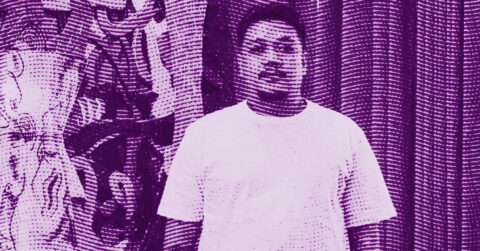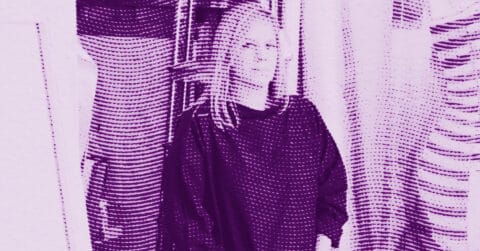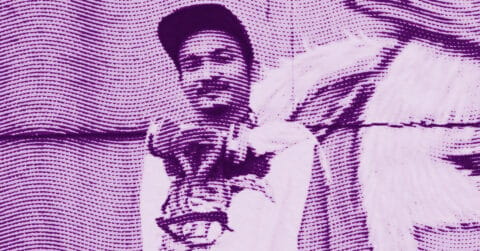Listen to me carefully, you bunch of snobs: Adam Pendleton practices a form of art that stubbornly refuses to be domesticated by your reassuring categories. For over two decades, this American conceptual artist born in 1984 has developed a visual and theoretical vocabulary that challenges our inherited conceptions of abstraction, history, and identity. His multidisciplinary work, including painting, silkscreen printing, video, performance, and publishing, revolves around the concept he forged of “Black Dada”, an enigmatic formula that functions less as a manifesto than as a conceptual virus, contaminating and reconfiguring everything it touches.
Pendleton’s artistic project is rooted in a fundamental questioning of the ways in which art can simultaneously possess and be possessed by contradictory ideals. This dialectic is expressed with particular acuity in his abstract paintings, where fragments of language, isolated letters, truncated words, and phrases repeated to the point of exhaustion of their meaning haunt compositions that evoke both abstract expressionism and urban signage. These works, created using a complex protocol combining spray paint, silkscreen printing, and photography, transform the canvas into a temporal testimony where the traces of an unfinished modernity are superimposed.
The exhibition “Who Is Queen?” at the Museum of Modern Art in New York in 2021-2022 was the most spectacular culmination of this research [1]. In the museum’s Marron Atrium, Pendleton deployed a total installation comprising three eighteen-meter-high black scaffolding structures, paintings arranged at different levels, video projections, and a sound collage mixing the voices of Amiri Baraka, Black Lives Matter protesters, and the music of Hahn Rowe. This total work of art for the 21st century directly challenged the museum institution while offering a radical alternative to the chronological presentation of the modernist canon. As Siddhartha Mitter wrote in the New York Times, Pendleton had “built his own museum within the MoMA, an experience of change from within, offering a radically different method of exhibition” [2].
This approach is part of a critical tradition that could be compared to Maurice Sendak’s literary approach in “Where the Wild Things Are” (1963). Like the American illustrator, Pendleton refuses to minimize the emotional and political complexity of his subject matter to make it more digestible. Sendak had created an imaginary space, the island of the Maximonsters, where young Max could express his anger and destructive impulses before finding comfort in the maternal home. This fantastical geography functioned as a laboratory of emotions, a place of experimentation where forbidden affects could unfold without irreversible consequences. Sendak’s book offered an alternative cartography of childhood, recognizing the legitimacy of “wild” emotions while maintaining the promise of a return to domestic order.
Pendleton operates in a similar manner by creating spaces of indeterminacy where historical and identity certainties can be suspended. His installations function as conceptual “wild lands” where visitors are invited to navigate without an ideological GPS. The concept of “Black Dada” that he has been developing since 2008 functions precisely as this intermediary space between familiar and strange, known and unknown. By associating the European Dada movement of the early 20th century, born out of the stupor of World War I’s destruction, with the emancipatory struggles of African Americans in the 1960s, Pendleton creates a temporal short-circuit that reveals the underground affinities between different forms of resistance to the established order. This strategy of unexpected juxtaposition evokes Sendak’s method, which transformed his Polish uncles and aunts into benevolent monsters, a metamorphosis that allowed him to tame the unsettling strangeness of the adult world.
The “Black Dada Reader” published in 2017 constitutes the theoretical laboratory of this approach [3]. This book-manifesto brings together texts by Hugo Ball, W.E.B. Du Bois, Stokely Carmichael, Sun Ra, Adrian Piper and many others in an assembly that defies all chronological or disciplinary logic. This experimental archive functions like a machine for producing improbable connections between historical figures that seemed to be separated by everything. By photocopying and recompiling these sources, Pendleton implements an aesthetic of appropriation that transforms the act of reading into a critical performance. The Reader does not merely document the concept of “Black Dada”: it activates it, puts it into circulation, makes it contagious.
This performative dimension of language finds its most accomplished expression in the paintings of the “Untitled (WE ARE NOT)” series, begun in 2018. These monumental canvases relentlessly repeat the phrase “we are not” until the words lose their denotative function to become pure plastic material. This strategy of exhausting meaning evokes the experiments of the American writer Gertrude Stein, whose “textual portraits” Pendleton has studied. In both Stein and Pendleton, repetition does not aim at redundancy but at revelation: it is by saying and repeating the same words that one discovers their hidden potentialities, their secret harmonics.
Pendleton’s work thus engages with a long tradition of American literary experimentation that ranges from Stein to John Ashbery via Amiri Baraka. This genealogy is not fortuitous: it reveals a conception of art as a space of resistance to simplifying identity logics. When Pendleton paints “we are not”, he does not produce a negative statement but opens up a space of infinite possibilities. “We are not” then becomes the beginning of a phrase that never ends, the promise of an identity in perpetual becoming.
This poetics of incompleteness finds its spatial translation in Pendleton’s installations. His scaffolding structures transform the exhibition space into a permanent construction site, a precarious architecture that refuses frozen monumentality. These devices evoke both Donald Judd’s constructions and the barricades of social movements, creating a productive ambiguity between order and disorder, permanence and temporality. The scaffolding becomes a metaphor for a society in perpetual construction, always on the verge of collapsing or metamorphosing.
This assumed instability perhaps constitutes the most radical aspect of Pendleton’s project. In an era where contemporary art often seems obsessed with clarifying its political positions, it deliberately chooses opacity, stuttering, indetermination. His works resist univocal interpretation not out of intellectual coquetry but out of political conviction. By refusing to deliver ready-made messages, they force the viewer to engage in a process of deciphering that transforms reception into a creative act.
This aesthetic of hermeneutic resistance finds its roots in the historical experience of the African diaspora. As shown by Édouard Glissant, opacity constitutes a fundamental right of subaltern cultures in the face of the colonial power’s enterprises of total transparency. By cultivating indetermination, Pendleton reactivates this tradition of resistance while shifting it towards the territory of contemporary art. His works become “bachelor machines” that produce meaning without ever exhausting it, generators of interpretations that keep open the question of their significance.
The exhibition “Love, Queen” currently presented at the Hirshhorn Museum until January 2027 pushes this logic of semantic proliferation even further. In the museum’s circular galleries, Pendleton’s works create a labyrinthine journey where each painting echoes the others in ways that escape any definitive systematization. This circulation of meaning between the works evokes the rhizomatic structure dear to Gilles Deleuze and Félix Guattari, another major reference of Pendleton. The 2016 exhibition “Becoming Imperceptible” explicitly paid homage to the French philosophers by borrowing its title from “A Thousand Plateaus”.
This theoretical filiation sheds light on the properly philosophical dimension of Pendleton’s work. Like Deleuze and Guattari, he conceives art as a war machine directed against identity capture apparatuses. His works operate through deterritorialization, tearing signs away from their original contexts to make them enter into new arrangements. The “Black Dada” functions precisely as one of those nomadic concepts that escape taxonomic fixation attempts.
This conceptual mobility explains the international dimension of Pendleton’s work. His exhibitions at the Palais de Tokyo, at the Mumok in Vienna, or at the Belgian pavilion of the Venice Biennale in 2015 showed the ability of his artistic vocabulary to adapt to different geopolitical contexts without losing its critical force. By questioning Belgium’s colonial heritage in the Congo, Pendleton revealed the underground connections between European history and African emancipatory struggles, updating the political scope of his aesthetic project.
This geopolitical dimension of the work finds its most direct translation in Pendleton’s videos. “Resurrection City Revisited” (2023) assembles archival footage from the “Poor People’s Campaign” of 1968 with geometric shapes that sometimes obliterate, sometimes halo the faces of the protesters. This graphic intervention transforms the historical document into a contemporary testimony where the past and the present resonate. The triangles and circles that punctuate the images evoke conceptual art as much as digital interfaces, suggesting a continuity between the struggles of the past and contemporary modes of resistance.
This layered temporality characterizes Pendleton’s entire project. His works do not propose a nostalgic vision of the past but an archeology of the present that reveals the temporal strata that compose it. By reactivating the heritage of Sol LeWitt, whose incomplete cubes haunt the “Black Dada” series, or by dialoguing with the spirit of freedom of Julius Eastman, a gay African-American composer whose radicality inspires several recent works, Pendleton practices a form of creative anachronism that explodes the linearity of historical time.
This non-chronological conception of history explains Pendleton’s fascination with cultural figures like Gertrude Stein or Glenn Ligon. These artists share a practice of aesthetic nomadism, navigating between the avant-gardes and communities, between Europe and America, between dominant codes and minority cultures. Pendleton fits into this lineage of cultural translators who transform borders into zones of creative contact.
The collaborative dimension of Pendleton’s work also testifies to this relational approach to creation. His collaborations with musicians like Deerhoof, choreographers like Ishmael Houston-Jones, or theorists like Jack Halberstam reveal a conception of art as a collective practice of producing meaning. These interdisciplinary encounters generate hybrid works that escape traditional classifications, creating new aesthetic territories at the crossroads of media.
The sound installation that accompanies “Who Is Queen?” perfectly illustrates this logic of creative contamination. By superimposing the voice of Baraka reading his poems, the music of Hahn Rowe, and the cries of the Ferguson protesters, Pendleton creates a temporal polyphony that resonates different generations of resistance together. This audio “counterpoint” technique, inspired by Glenn Gould, transforms the exhibition space into a historical echo chamber where voices from the past and present mix.
This aesthetic of superposition finds its plastic equivalent in Pendleton’s recent paintings. The works from the “Black Dada” series presented in the exhibition “An Abstraction” at the Pace Gallery in 2024 mark a significant evolution compared to the previous monochromes. The introduction of vibrant colors, intense purples, metallic greens, brilliant yellows, transforms the artist’s palette while maintaining the logic of stratification that characterizes his approach. These new canvases function like screens where different temporalities collide, creating depth effects that evoke both archeology and science fiction.
This complex temporal dimension explains Pendleton’s growing interest in new technologies. His recent experiments with virtual reality and artificial intelligence reveal a willingness to explore the aesthetic potential of digital media without abandoning traditional mediums. This techno-critical approach echoes that of artists like Hito Steyerl or Zach Lieberman who question the contemporary modalities of image production and circulation.
The commercial and institutional success of Pendleton, his entry into Pace Gallery in 2012, his acquisitions by the MoMA and the Guggenheim, his recent recognition by the American Academy of Arts and Letters, testifies to the ability of his work to navigate between the avant-garde and the art market. This ambivalent position is not fortuitous: it reveals the complex strategy of an artist who uses the dominant circuits to disseminate potentially subversive proposals. By occupying the most prestigious institutions, Pendleton practices a form of diversion that transforms the temples of culture into laboratories of political experimentation.
This tactical instrumentalization of existing structures evokes the approach of certain postcolonial writers who turn the language of the colonizer against itself. Pendleton operates a similar maneuver by using the codes of Western conceptual art to express experiences and stories that exceed this framework. This “cannibalistic” approach, to use the metaphor developed by the Brazilian anthropophagi, transforms assimilation into a creative process of cultural mixing.
Pendleton’s work thus reveals the critical potentialities of an art that refuses conceptual purity to embrace the complexity of the real. By cultivating indeterminacy, it keeps open possibilities of meaning that identity logic tends to close. His installations and paintings become spaces of freedom where the imagination can experiment with new forms of subjectivity, new modalities of living together.
This utopian dimension of Pendleton’s project is not naive idealism but visionary pragmatism that takes stock of the impasses of the present to imagine other possible configurations. By refusing to choose between abstraction and figuration, between art and politics, between local and global, it opens alternative paths that escape the paralyzing dichotomies of the era. His work testifies to the ability of contemporary art to produce forms of resistance that do not merely denounce the existing but concretely invent new ways of being in the world.
The exhibition “Love, Queen” at the Hirshhorn Museum constitutes the provisional culmination of this research. In the circular galleries of Washington, Pendleton’s works create an immersive environment that transforms the visit into an experience of productive disorientation. Viewers are confronted with a visual vocabulary that resists immediate decoding, forcing them to slow down, to suspend their usual interpretive reflexes. This dilated temporality perhaps constitutes the most precious aspect of Pendleton’s work: in a world dominated by acceleration and the instantaneous, it creates oases of critical contemplation where thought can catch its breath.
This resistance to contemporary speed is part of a critical tradition that traverses 20th-century art, from Paul Cézanne to American minimalists. Like these predecessors, Pendleton understands that transforming the gaze requires a transformation of time. His works impose their own rhythm, forcing the viewer to accept a form of slowness that becomes the condition of possibility for a true aesthetic encounter.
This particular temporality explains the fascination effect produced by Pendleton’s works. Faced with his paintings with apparently simple but infinitely complex compositions in their execution, faced with his installations that transform the exhibition space into a conceptual playground, the viewer experiences a form of contemporary sublime that no longer passes through crushing but through the opening of infinite possibilities. These works remind us that art, at its best, does not merely represent the world but transforms it by revealing previously invisible potentialities.
Adam Pendleton’s work thus constitutes a privileged laboratory for thinking about the aesthetic and political stakes of the 21st century. By refusing the easy ways of militant discourse as well as those of pure aesthetics, he invents forms of resistance that pass through complexification rather than simplification. His “Black Dada” functions like a conceptual virus that contaminates and transforms everything it touches, creating new spaces of freedom in a world saturated with certainties. From this perspective, indeterminacy becomes not an obstacle to understanding but a condition of possibility for social transformation. Pendleton’s art reminds us that the future remains open, provided we accept navigating the creative uncertainty of the present.
- Adam Pendleton: “Who Is Queen?”, Museum of Modern Art, New York, September 18, 2021 – January 30, 2022.
- Siddhartha Mitter, “Adam Pendleton Is Rethinking the Museum”, The New York Times, September 10, 2021.
- Adam Pendleton, Black Dada Reader, éd. Stephen Squibb, Londres, Koenig Books, 2017.
- Terence Trouillot, “Adam Pendleton Celebrates Poetry, Wildness and Black Resistance”, Frieze, September 22, 2021.
















